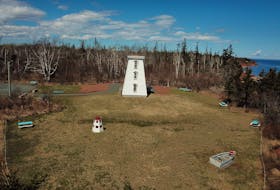
CAPE FORCHU - A century-old building that once rang with the sounds of music, laughter and dancing has been reborn as a tiny house in Cape Forchu, Yarmouth County.
Known locally as the “old schoolhouse,” the deserted landmark was often photographed for its picturesque beauty next to Outer False Harbour Beach with the Cape Forchu lighthouse in the background.
The past
The old schoolhouse building was constructed in 1908 with lumber from the old Yarmouth Yacht Club on the Yarmouth waterfront.
It was built by Walter Sweeney. The family later moved to town and the building was eventually purchased by the community.
In the early 1940s the building was used as a schoolhouse after an RCF airplane crashed near an old schoolhouse by the Yarmouth Bar, killing all of its crewmembers and causing some smoke and fire damage to the schoolhouse there.
As the years went by, the children were eventually bussed to a school in town and the building reverted back to the community.
Cape Forchu resident Margaret Sweeney says her late husband Clifton would help maintain the building and that baby and wedding showers were held there.
Former resident Noel Ragsdale remembers the summer dances.
“I recall the schoolhouse room being really packed – it seemed as though everyone on the Cape was there,” Ragsdale says. There were fiddle players and other musicians, as well as a square-dance caller. “The dancing was for the grownups and they were really complex and really good. The kids (like me) were at the dances, but we were spectators and also spent a lot of time playing outside.”
Every now and then a parent would partner with a child in the dance set, which was an honour and also a real challenge – to keep up with all the calls and not “mess up” the set.
Sometimes the dances included a dessert contest/auction. The pies, cakes, brownies, etc. would come up for bidding and the highest bidder would get the dessert.
“A lot of the desserts were really elaborate and impressive. I remember my sister and I baking something for the auction – bob which was probably really pathetic – and being terrified that no one would bid. We were saved by our father who bought it,” says Ragsdale.
Helen Beveridge discovered Cape Forchu in 1935 when she arrived to begin her teaching career. She spent well over 70 years loving the Cape. She bought the Old Schoolhouse in 1967 from Gladys and Ed Sweeney, who helped put up inside walls to divide the one large room into two bedrooms, a great room and kitchen area.
One of the first things Beveridge did was put in a new window in her bedroom so that she could look at the lighthouse from her bed. After a powerful storm the cottage shifted and when she returned the following summer the view of the lighthouse was gone. A family reunion was held there in 1983. Beveridge remained the sole owner until very late in her 80's when it became too difficult to travel from her home in Truro to her beloved Cape. She died in 2009 at the age of 93.
Flooding over the nearby berm into the surrounding salt marsh was becoming an increasing problem and the building began rotting and buckling.
Vandals began to attack the structure.

Two years ago
When the old schoolhouse was put up for sale, it drew interest despite its postage-stamp-sized lot and flooding issues. Its spectacular location near the beach was hard to beat.
Carolyn Campbell bought the place sight unseen. Her son Shane Campbell has been fascinated by architecture since childhood. His first co-op work term through Dalhousie University was with Mackay-Lyons Sweetapple Architects Ltd. from September to December 2012.
Shane worked at measuring another old schoolhouse, the Chebogue schoolhouse in Yarmouth County built in 1914, and prepared drawings of it before it was dismantled and reconstructed on Brian MacKay-Lyons’ Shobac property in Kingsburg. He graduated with his Master of Architecture in October 2016.
He says he could see the vision connected with the Cape Forchu property.
“A lot of people saw the price tag and thought it was too much for the property, but I saw the lumber… there was value inherent in the old building and that kind of led and drove the whole project,” he says.
For months, Shane and Carolyn struggled with the idea of preserving the old building.
“I had done full-drawing detail specs for it and thought about putting it up on stilts,” says Shane.
Eventually, financial and environmental considerations helped them to decide to construct a tiny house incorporating lumber from the old structure. Because the tiny house would be on a trailer, it could be wheeled out before a big storm.
To begin, 20 tandem truckloads of fill were dumped and spread to raise the building site above the area prone to flooding.
The container
Tearing down the schoolhouse was an enormous task that took months, but Shane was game. He’d just spent four-plus years behind a desk and found the physical work liberating.
A container (from CTS in Burnside) became a 300-square-foot secure job shack, a central pillar to the project as it was something to work out of.
As he dismantled and tore down the old schoolhouse building, he made lumber racks inside the container for the old wood.
The container also became a mechanical space for the hot water heater, water pump, electrical entrance and 100-amp panel – everything that supplies the tiny house.
Pipes and cables are underground, fed into a trench laid with ABS pipe and snaked up beneath the tiny house.
“Everything’s hidden, clean. The idea is you unplug it and wheel it out,” says Shane.
The container is wired with plugs and lights and part of it will become a bunkhouse in the future.

Saving the old
In the fall of 2016, Shane went on the family woodlot with his uncle, Frank Campbell, and they started cutting pine and red spruce for framing countertops and other elements for the tiny house.
The wood was stacked, stickered and left to dry naturally for the better part of a year or more, depending on the wood type, thickness and final use. The design process coincided with and paralleled the demolition of the old building.
A crowbar and sledgehammer were Shane’s main tools for dismantling. When he got out the chainsaw and started cutting the roof trusses, some of his friends helped out.
But there came a point when he realized he couldn’t keep it all, and so rotting floorboards and other undesirable wood was stacked in a 20-foot-tall pile and burned. He says the bonfire served as a celebration and a farewell to the old building.
Very little debris went to the landfill.
“The second I had it all torn down and a million nails pulled out and the wood stacked all nice in the container, everybody wanted it,” Shane says, smiling.
Building the new
Tiny houses have been a growing trend. Shane watched hundreds of tiny house episodes and researched online. His plan was designed in 3D using SketchUp.
A 24-by-eight-foot galvanized steel trailer built at Skipper’s Welding Shop in West Pubnico serves as the foundation for the structure.
Because the view is important, eight custom-made, tempered windows were installed, including a patio door beachside. Hunter-Douglas semi-transparent blinds provide shade and privacy.
His favourite window is the one you experience upon entering – the clerestory window provides flooding light from above.
The interior design provides a feeling of being in a larger space, with a 10.5-foot ceiling in the southern “sitting area” and huge expanses of glass drawing visitors towards a vista of ocean, beach, sky and salt marsh.

There’s a two-foot-by-three-foot entrance closet, three-piece bath and additional storage in the loft above. The single loft is a fun place for grandkids, or one adult.“We’ve got a lot squeezed in here for the square footage,” says Shane.
With the main loft, single loft and the couch, the place sleeps five adults. Shane has one brother, two sisters, and six nieces and nephews.
Just recently, he constructed a 14-foot table to set on pavers outside for larger gatherings. He plans on making a couple of benches next year.
The galley kitchen has a full-sized fridge, pantry and eight-foot countertop with a large sink.
For cooking, there are two induction cooktops, plus a toaster oven.
“With this property, a lot of it is about eating outdoors, with an outdoor kitchen eventually mirroring the one inside,” says Shane. “We did a lot of cooking in the container during the building process.”
He advised his mother to have a main-level bedroom in the tiny house, in consideration of aging.
“But she was really gung-ho on the loft. If ever she needs to, this is a fold-out bed here,” he says, pointing to the futon.
There’s a 1,000-gallon underground cistern on the south supplying water. A septic tank and field bed are on the north. The bathroom features a composting toilet.
Building details
The exterior of the tiny house is an open joint rain screen cladding system with a special UV stable building wrap, which allowed the use of the old wood to be repurposed and re-milled as a protective outer layer.
Unlike most cladding systems, this makes a space and a black reveal between each board, creating a “unique, clean contemporary façade that holistically complements and integrates the black-framed windows,” says Shane.
All the framing of the structure was from red spruce cut and milled from the family woodlot in Kempt. The floors, kitchen and table were all made of pine, cut and milled from the woodlot. The shiplap interior is made from the old building walls and ceilings. It was originally tongue and groove bead board.
Shane had to cut off the tongue and groove, plane off the paint and re-mill the boards into shiplap.
The feature walls consist of the sheathing boards from the old building, “with all their glory and character gained over the past century,” he says.
There was virtually no purchased lumber used. Everything was either cut and milled from the woodlot or reclaimed wood salvaged from the old schoolhouse building.
A notable feature of the building is the exposed framing and shiplap throughout the building interior. This design intent required the building to be insulated, he says, and on the outside “outsulated.”

Shane’s thoughts
“Given that it is built primarily of wood from the old schoolhouse building, the new building is contextually better suited and more rooted to the site than initial impressions and or visual cues would suggest,” says Shane. “The new building is a re-manifestation of the neglected and forgotten 100-year-old building, and through its recent morphology, has the potential to live 100 years longer.”
He says this was really a project of making the most with what was there.
“Dismantling the old building and re-using the old lumber seemed natural and just right in a time when things are becoming abundant, cheap and easily accessible,” he says, explaining this was a project about taking time and doing the right thing, while “appreciating the hard work, the time and effort it took our ancestors to make something, back when oxen and cattle were used to harvest lumber.”
He says the process was about connecting, appreciating, reflecting and understanding.
“In the end the outcome was a fraction of the time and effort of our predecessors and in doing so it has given the old building a new life and has reduced the strain on the environment,” he says.
He says the building basically designed itself. All he had to do was read the site and be resilient with what was there.
“I like to say that the building is a new building but one with an old soul.”
How to reach the builder
Shane Campbell can be emailed at
READ OUR COLLECTION OF THEN AND NOW STORIES
• Tiny house, big view: New home, old soul in Cape Forchu, Yarmouth County CLICK HERE
• Random Digby County find leads to huge loss in leatherback sea turtle research CLICK HERE
• Sam Langford’s story ‘Chasing Champions’ coming to the Marc Lescarbot Theatre as his legacy lives on CLICK HERE
• Celebrating Yarmouth area’s sports history CLICK HERE
• Running shoes, equipment, have come a long way CLICK HERE
• ‘I wanted to keep it here for everyone to enjoy’ – New life for historic Robertson building in Barrington Passage CLICK HERE
• Historic Milton horse returns to Yarmouth for its perch back on 1893 fountain CLICK HERE
• How a 1963 fire reshaped a streetscape in downtown Yarmouth CLICK HERE
• Rural internet efforts continue as travel the information highway in southwestern Nova Scotia CLICK HERE
• ‘I love upholding the tradition’ – 1880 history lives on at Shelburne Dory Shop CLICK HERE
• What was it? Shared story of September daytime UFO sighting in Cape Sable Island has people talking CLICK HERE
• Electric City: ‘We may not have everything we started out with, but we still have the story’ CLICK HERE
• COLUMN: Laurent d’Entremont: Turning back the clock to my childhood days CLICK HERE
MORE TO COME….








